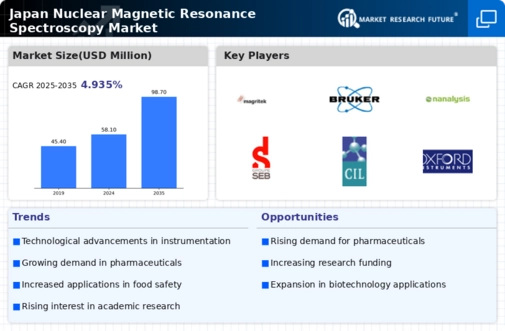Growth in Academic Research Funding
In Japan, the nuclear magnetic-resonance-spectroscopy market is benefiting from increased funding for academic research. Government initiatives aimed at enhancing scientific research capabilities have led to a surge in financial support for universities and research institutions. This funding is often allocated towards acquiring advanced NMR equipment, which is crucial for various scientific investigations, including materials science and biochemistry. As of 2025, it is estimated that research funding in Japan will exceed $10 billion, with a significant portion directed towards enhancing analytical capabilities. This influx of resources is likely to bolster the nuclear magnetic-resonance-spectroscopy market, as institutions seek to leverage cutting-edge technology for groundbreaking discoveries.
Emerging Applications in Food Safety
The nuclear magnetic-resonance-spectroscopy market is witnessing a shift towards applications in food safety and quality control in Japan. With increasing consumer awareness regarding food safety, there is a growing demand for reliable testing methods to ensure product integrity. NMR spectroscopy offers a non-destructive means of analyzing food products, allowing for the detection of contaminants and the verification of authenticity. The food industry in Japan is projected to grow at a CAGR of 4% through 2025, further driving the need for advanced analytical techniques. This trend suggests that the nuclear magnetic-resonance-spectroscopy market will expand as food manufacturers and regulatory bodies seek to implement stringent quality assurance measures.
Technological Integration in Healthcare
The integration of advanced technologies in healthcare is significantly impacting the nuclear magnetic-resonance-spectroscopy market in Japan. As healthcare providers increasingly adopt precision medicine approaches, the demand for sophisticated diagnostic tools is on the rise. NMR spectroscopy is being utilized for non-invasive imaging and biomarker discovery, enhancing patient care and treatment outcomes. The healthcare sector in Japan is expected to grow to $500 billion by 2025, with a substantial portion allocated to innovative diagnostic technologies. This growth indicates a promising future for the nuclear magnetic-resonance-spectroscopy market, as healthcare professionals seek to incorporate advanced analytical methods into routine practice.
Rising Demand in Pharmaceutical Research
The nuclear magnetic-resonance-spectroscopy market in Japan is experiencing a notable increase in demand, particularly within the pharmaceutical sector. As the country invests heavily in drug development, the need for advanced analytical techniques becomes paramount. NMR spectroscopy is essential for elucidating molecular structures and understanding complex interactions in drug formulations. In 2025, the pharmaceutical industry in Japan is projected to reach a market value of approximately $50 billion, with NMR spectroscopy playing a critical role in research and development processes. This trend indicates a robust growth trajectory for the nuclear magnetic-resonance-spectroscopy market, driven by the necessity for precise and reliable analytical methods in drug discovery and quality assurance.
Increased Focus on Environmental Monitoring
The nuclear magnetic-resonance-spectroscopy market is also influenced by a heightened focus on environmental monitoring in Japan. As environmental regulations become more stringent, industries are compelled to adopt advanced analytical techniques to assess the impact of their operations. NMR spectroscopy provides valuable insights into the chemical composition of environmental samples, aiding in pollution control and compliance with regulatory standards. The environmental monitoring market in Japan is projected to grow at a CAGR of 5% through 2025, which may lead to increased adoption of NMR technology. This trend suggests that the nuclear magnetic-resonance-spectroscopy market will benefit from the growing need for precise environmental assessments.




















Leave a Comment